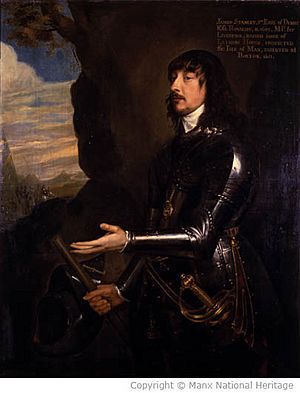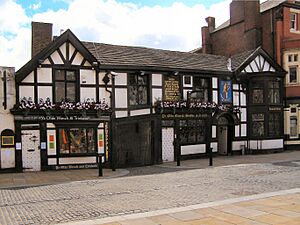Storming of Bolton facts for kids
Quick facts for kids Storming of Bolton |
|||||||
|---|---|---|---|---|---|---|---|
| Part of First English Civil War | |||||||
|
|||||||
| Belligerents | |||||||
| Commanders and leaders | |||||||
| Prince Rupert | Alexander Rigby | ||||||
| Strength | |||||||
| 2,000 cavalry 6,000 infantry |
ca. 4,000 | ||||||
| Casualties and losses | |||||||
| Unknown | 78–2,000 | ||||||
The Storming of Bolton was a fierce battle during the First English Civil War. It happened on May 28, 1644. The town of Bolton, which strongly supported Parliament, was attacked and captured by Royalist forces. These forces were led by Prince Rupert.
Some people called this event the "Bolton massacre." Reports said that up to 1,600 of Bolton's defenders and people living there were killed. This happened during and after the fighting. The "massacre at Bolton" became a key part of Parliament's messages to gain support.
Contents
Why the Battle Happened
Tensions in Lancashire
Before the Civil War began, there were disagreements in Lancashire. Towns often supported Parliament. But rich landowners and nobles, called the gentry and aristocracy, usually supported the King. They were known as Royalists.
There were also religious differences. Some towns supported different Protestant groups. Bolton was even called the "Geneva of the north." This was because it was a center for a Protestant faith called Calvinism.
Royalist Challenges
A main Royalist leader in Lancashire was James Stanley, 7th Earl of Derby. He was slow to act when the war started in 1642. He also failed twice to capture Bolton the next year. He then left Lancashire for a while to focus on the Isle of Man.
The only threat to Parliament's control in Lancashire came from Cheshire. A Royalist army there was led by John Byron, 1st Baron Byron. But on January 26, 1644, Byron's army was defeated. This happened at the Battle of Nantwich. Parliament's forces, led by Sir William Brereton and Sir Thomas Fairfax, then controlled the area.
Siege of Lathom House
After their victory, Fairfax's army and some Lancashire Parliamentarians started to attack Lathom House. This was the home of the Earl of Derby. His wife, the Countess of Derby, defended it.
However, Fairfax then moved his army to Yorkshire. He went to join his father, Lord Fairfax.
Prince Rupert's Plan
Royalist Strategy
The Royalists decided to send Prince Rupert to the northwest. He was the King's nephew and best military leader. His job was to improve the Royalist position there.
Rupert set up his main base in Shrewsbury. From there, he led his forces to help the town of Newark. It became even more important to control the northwest when the Fairfaxes and a Scottish army began to attack York. This attack started on April 22.
March to Lancashire
Rupert did not have enough soldiers to go straight to York. So, a meeting in Oxford decided he would first go to Lancashire. He would help the Royalists there. He would also use the Earl of Derby's influence to get more soldiers. Another goal was to capture the port of Liverpool. This would allow messages and supplies to come from Royalist forces in Ireland.
Rupert and the Earl of Derby marched north on May 16. He added Byron's army from Cheshire and North Wales. This gave him 2,000 cavalry (soldiers on horseback) and 6,000 infantry (soldiers on foot). To cross the Mersey, he needed to secure a crossing point. He chose Stockport and attacked it on May 25. The town was not well defended. After a short fight, the defenders ran away to Manchester.
When Colonel Rigby's forces heard that Stockport was lost, they stopped attacking Lathom House. They went back to Bolton. Colonel Shuttleworth was in charge of the soldiers defending Bolton.
The Attack on Bolton
The Battle Begins
Late on May 28, Prince Rupert got close to Bolton. He sent Colonel Henry Tillier with soldiers to secure the town. They found the Parliamentarian soldiers arriving from Lathom House in a confused state.
When Rupert heard this, he sped up his march and attacked right away. It was raining heavily. The Parliamentarians formed a defensive line around the town with 4,000 men. Rupert's first attack was pushed back. His soldiers suffered 300 casualties (killed or wounded).
Royalist Victory
Prince Rupert then ordered another group of soldiers to attack again. Led by the Earl of Derby, they succeeded. Fighting continued in the streets. The Parliamentarian forces were either defeated or ran away.
The Royalists claimed they killed 1,000 Parliamentarian soldiers. They also said they captured 50 officers and 600 other prisoners. They took 20 flags, 20 barrels of gunpowder, and many weapons.
The Parliamentarian commander, Colonel Alexander Rigby, escaped. He learned the Royalist secret password and got away. He went to the armies attacking York. He claimed that 1,500 of his soldiers were poorly armed "clubmen." He also said he only lost 200 men, and the rest had fled. But other commanders noted that "common reports" said many more had been killed.
Why It Was So Brutal
Sudden Attack and Plunder
The attack on Bolton was a very harsh event in the Civil War. Unlike a formal siege, which often involved talks and surrender, Rupert attacked suddenly. He caught the Parliamentarians off guard.
Because there was no chance to negotiate, the soldiers defending the town had little protection. Fighting happened in the streets. People living in the town got caught in the battle. It was also night and raining hard, making it hard to tell soldiers from citizens.
Royalist soldiers were allowed to take things from the town as a reward. This meant that citizens might have died during this time.
Irish Soldiers and Anger
At least two of the Royalist groups attacking Bolton had fought in Ireland before. They had returned to England in 1644. Parliamentarians believed these soldiers were Catholics from Ireland.
The Royalists claimed that during the fight, the Parliamentarians hanged a captured Irishman. They called him a "Papist" (a term for a Catholic). This made the attackers very angry. One Royalist group, Tyldesley's regiment, had many Roman Catholics from Lancashire.
What Happened Next
After Bolton
After taking Bolton, Rupert's army rested at Bury. They got more soldiers there. Then, they moved to Liverpool and started to attack it on June 6. On June 10, after breaking holes in the town's walls with cannons, the Royalists attacked. But they were pushed back.
During the next night, the Parliamentarians left Liverpool by ship. They left their flags on the walls to trick the Royalists. The next morning, Royalist soldiers entered the town. They found 400 defenders who were "of the meaner sorte" (poorer people). Many of them were killed, and only some were spared.
Rupert's Next Moves
The only major Parliamentarian stronghold left in Lancashire was Manchester. It was well defended and would have taken a long time to capture. King Charles told Rupert to hurry to help York. Rupert reached York on July 1.
The next day, he fought the armies that were attacking York. This battle was the Battle of Marston Moor, and Rupert was badly defeated. He went back to Lancashire and then south to join the King.
Lord Byron was left to hold the northwest. On August 19, his cavalry was defeated at the Battle of Ormskirk. The Royalists then gave up Lancashire. Bolton was recaptured in September without much fighting.
On September 18, Byron's army was destroyed while trying to help Montgomery Castle. Parliamentarian forces recaptured Liverpool on November 1. The commander, Sir John Meldrum, spared the soldiers defending Liverpool. This was even though Parliament had a rule to give "no quarter" (no mercy) to Irish soldiers. Lathom House was attacked again from July 1644. It held out until December 2, 1645.
The End of the Earl of Derby
At the end of the Third English Civil War, the Earl of Derby traveled north. He was captured near Nantwich and was initially spared. However, he was put on trial on September 29, 1651. He was found guilty of treason (betraying the King) for talking with King Charles II.
His request for forgiveness was denied. He escaped but was caught again. On October 15, 1651, he was taken to Bolton. He is said to have spent his last hours at Ye Olde Man & Scythe pub. But it is more likely he was in another house nearby. He was then beheaded (had his head cut off) near the Market Cross on Churchgate.
See also



